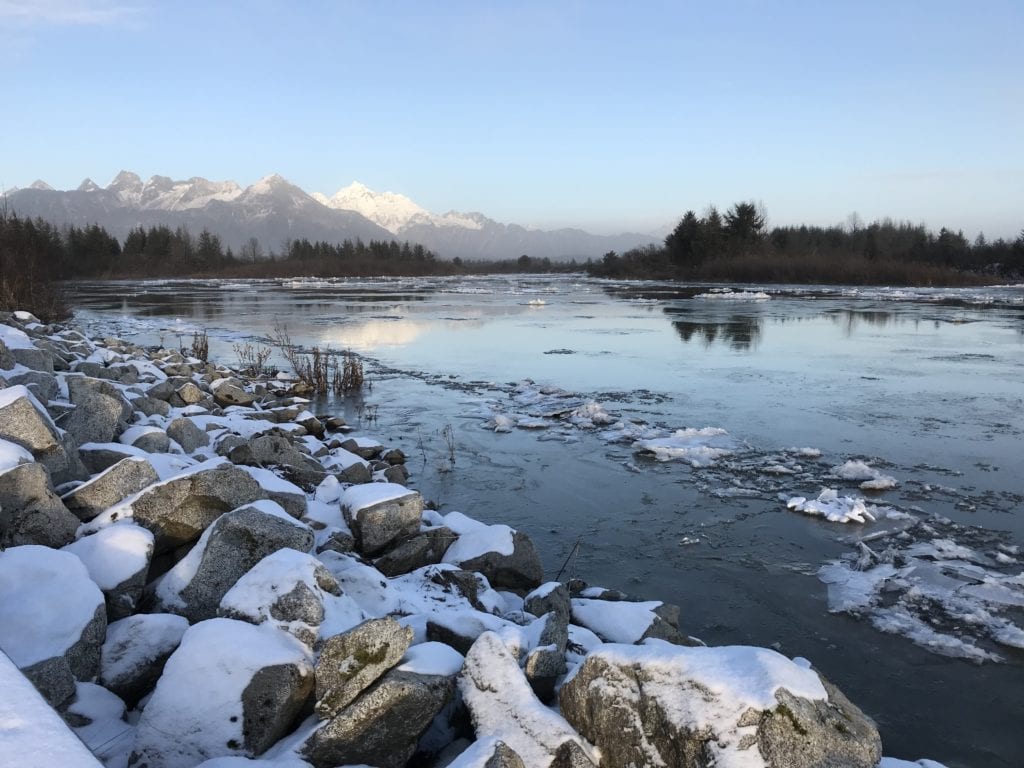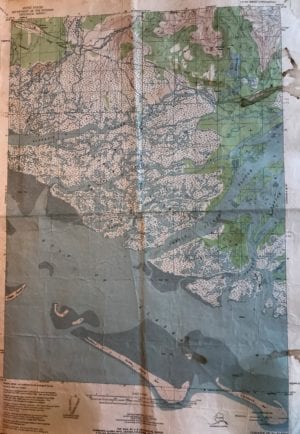
With their vessel aground on a sandy beach outside of Cordova, taking a heavy beating in the surf and no one aware of their circumstance, North Cloud engineer Robert Holeman decided to head for help.
It was 9 a.m. Feb. 21, 1949, when he donned rubber boots and warm clothing, clambered off the 105-foot power barge, pulled on a backpack containing survival supplies, and started off on a daunting trek toward the Mile 13 airport.
Left behind and counting on his success were Fred Howard and his wife, plus their son-in-law, Robert Zentmire.
The first obstacle Holeman faced was water covered with ice packs that stretched 4 miles between the low sand bar he was on and the nearest solid banks of the Copper River Delta mainland.
The very same ice, which floated back and forth on the tides, would later present a major hinderance to vessels making rescue attempts.
When I asked longtime Cordova fisherman Jim Webber about this crossing, he said it would be possible, but challenging, and had to be at low tide.
Especially in 1949, for this was 15 years prior to the 8-foot uplift of the Delta caused by the 1964 Good Friday earthquake, which meant that water levels at that time were that much higher than they are today.
By good fortune, it must have been near low water when Holeman began his endeavor, and he would have roughly nine hours of daylight to start with. The weather was not mentioned in his later account of the long journey, but much of his trek had to be in darkness, for sunset was around 6 p.m., and sunrise about 8 a.m.
Here are excerpts of Cordova Times Editor Everett Pettijohn’s account of Holeman’s amazing effort, headlined “Engineer Treks 30 Miles In Snow To Report Wreck,” from the Feb. 23, 1949 edition.

“Holeman took off wearing rubber boots so he could wade through two feet of water to get on the mainland, completely frozen over at the present, then some 25 miles through waist-deep snow and through and around sloughs. He arrived at Mile 13 yesterday about 1 p.m. after the 28-hour grind, a trek that would have been impossible by less hardy men.
“After floundering in deep snows, the engineer came to a spruce thicket, where he cut boughs and using cords from his pack sack fashioned crude snowshoes. He said this made the going easier.
“Holeman said he stopped for an hour Monday night to build a small fire and hover over it to get warm. He carried K-rations taken from the barge.”
Left out of the report were so many unanswered details. Did he have a compass to maintain direction in the dark? Did he carry a flashlight? How about spare dry clothes?
Holeman mentioned crossing frozen sloughs. Did he traverse across the lower edge of the Delta mainland, which meant having to cross Alaganik Slough at its half-mile-wide entrance? This seems unlikely, since back before the earthquake uplift, tides of almost any size lifted and dropped the ice at that point.
Anyone who has driven to the end of today’s Alaganik Landing road in the winter can witness the impact of tides on ice crunching in and out, and this is several miles upstream where it’s much narrower.
If headed inland, did he discover railroad tracks left over from the Copper River Railway? In 1949, a dirt road over that rail bed reached just a few miles beyond the airport. Yet he surely would have mentioned that track as a clear guide to Mile 13, and likely a source for easier trekking, with a firm base under the deep snow.
This much for sure — it was an amazing achievement, spurned in part by adrenaline, and reflecting great courage.
“I hope I never have to make such a trek again, but a fellow has to do those things in a pinch,” Holeman said later.
He paid a price for his heroic efforts. It was later necessary to amputate the frozen toes on one of his feet.
But it paid off.
Within a few minutes after his arrival, Cordova Air Service Manager Merle Smith dispatched pilot Stewart Starbuck and observer Jack Downing to locate the barge. Starbuck, a former WWII fighter pilot, was one of his best aviators; Downing, who graduated from CHS in 1931, fished the flats for years, and had vast knowledge of the area.
Plus, their quick departure was an indication that weather was much improved.
Forty minutes later, they spotted the North Cloud, aground in ocean surf off the eastern end of Grass Island bar.
They were also startled to see a trio of survivors — the Howards and their son-in-law Robert Zentmire — waving from a makeshift lean-to structure, built of plywood and other material taken from the barge, and located near the top of the low grassy island.
Coming up next week, part three: With fears of bad weather approaching, rescue efforts begin.





